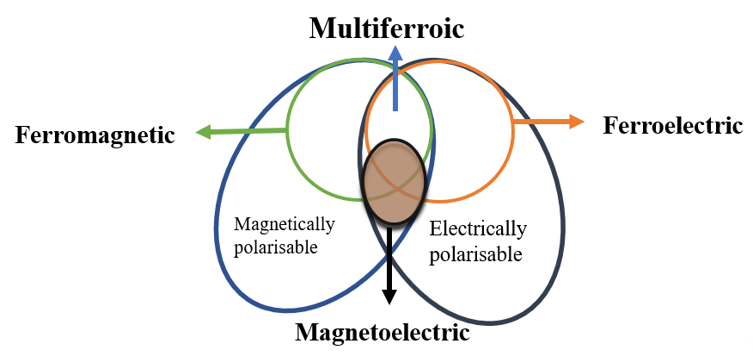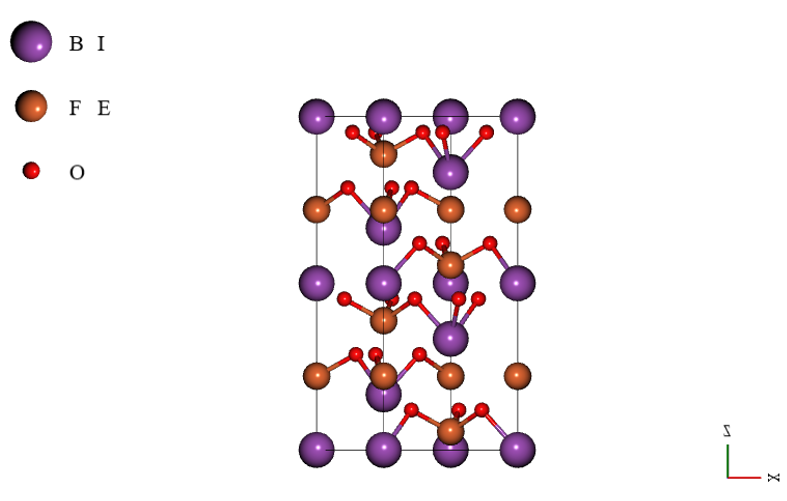Bismuth ferrite was first discovered to harness its ferroelectric and magnetoelectric properties; the bulk BFO prepared in the 1960s–1970s were marred with high conductivity and secondary phases, which resulted in the loss of motivation over the years. It was not until the early 2000s that the research in single crystals [26], high-quality BFO thin films [27], and ceramics [28] brought back researchers into BFO. It is an ABO3 type perovskite compound that crystalizes into the rhombohedral R3c group, hence possessing multiferroic properties due to its noncentrosymmetric nature. In ABO3, perovskite A is Bismuth (Bi) and occupies the corner of the perovskite unit cell, B is iron (Fe), the central atom with an oxygen octahedral arrangement. There is a tilting of oxygen octahedral, which doubles the pseudocubic unit cell giving rhombohedral unit cell. There is an equivalence between pseudocubic unit cell, rhombohedral and hexagonal unit cell representation and hence Figure 2 gives the hexagonal representation. The ferroelectric Curie temperature (TC) of BFO is as high as ~1103 K and antiferromagnetic Neel temperature (TN) is ~643 K. It exhibits a weak net magnetization as the G- type magnetic ordering with an incommensurate cycloidal spin structure having a periodicity of 62 nm. The chemical substitution of A and B sites are considered as one of the alternatives for enhancing the net magnetization via disruption of the cycloidal chain
- magnetoelectric coupling
- bismuth ferrites
Note:All the information in this draft can be edited by authors. And the entry will be online only after authors edit and submit it.
1. Introduction
The relation between the electric and magnetic subsystems can vary among the materials and also existing conditions; for instance, Bismuth ferrite theoretically, at room temperature shows quadratic and higher-order relation, while a linear behavior is observed at application with high electric fields or magnetic fields around 10–18 T [1,2], for the bulk and about 3–6 T for thin film samples depending upon their substrate [3]. Recently there have been many review papers related to Bismuth ferrite (BFO) [4–7] and its magnetoelectric coupling but this paper stands out from the rest in providing theoretical background and practical knowledge needed in a way that could be understood by a reader who is even new to the topic. Most review papers do not provide any information regarding measurement techniques employed for magnetoelectric coupling and hence this review aims to bridge this gap so that a reader can acquire both theory and practical knowledge at the same time.
The interrelation between the electric and magnetic leading to the magnetoelectric effect is schematically represented in Figure 1. There are two main important events in history that marked the discovery of the magnetoelectric effect (ME) effects:
- Röntegen discovered in 1888 that the moving dielectric was magnetized in the electric field [8] and the converse effect of polarization in the magnetic field by Wilson [9].
- Later in 1894, Curie suggested a possible existence of magnetoelectric behavior in crystals with only symmetry conditions [10].
Figure 1. Schematic representation of interrelation between electric and magnetic fields with respect to their polarization.
2. Bismuth Ferrite: Historical Background and Properties
It was not until the early 2000s that the research in single crystals [26], high-quality BFO thin films [27] and ceramics [28] brought back researchers into BFO. It is an ABO3 type perovskite compound that crystalizes into rhombohedral R3c group, hence possessing multiferroic properties due to its noncentrosymmetric nature. In ABO3, perovskite A is Bismuth (Bi) and occupies the corner of the perovskite unit cell, B is iron (Fe), the central atom with an oxygen octahedral arrangement. There is a tilting of oxygen octahedral, which doubles the pseudocubic unit cell giving rhombohedral unit cell. There is an equivalence between pseudocubic unit cell, rhombohedral and hexagonal unit cell representation and hence Figure 2 gives the hexagonal representation. The ferroelectric Curie temperature (TC) of BFO is as high as ~1103 K and antiferromagnetic Neel temperature (TN) is ~643 K. It exhibits a weak net magnetization as the G- type magnetic ordering with an incommensurate cycloidal spin structure having a periodicity of 62 nm. The chemical substitution of A and B sites are considered as one of the alternatives for enhancing the net magnetization via disruption of the cycloidal chain.
Figure 2. The crystal structure of Bismuth ferrite with hexagonal coordinates, drawn using BURAI software (software development credit: Satomichi Nishihara).
3. Applications
Applications
3.1 Energy Harvesters
3.2 Field Sensors
3.3 Magnetoelectric Random Access Memory
References
- Tokunaga, M.; Akaki, M.; Ito, T.; Miyahara, S.; Miyake, A.; Kuwahara, H.; Furukawa, N. Magnetic control of transverse electric polarization in BiFeO3. Commun. 2015, 6, 5878, doi:10.1038/ncomms6878.
- Kawachi, S.; Miyahara, S.; Ito, T.; Miyake, A.; Furukawa, N.; Yamaura, J.I.; Tokunaga, M. Direct coupling of ferromagnetic moment and ferroelectric polarization in BiFeO3. Rev. B 2019, 100, 140412, doi:10.1103/PhysRevB.100.140412.
- Agbelele, A.; Sando, D.; Toulouse, C.; Paillard, C.; Johnson, R.D.; Rüffer, R.; Popkov, A.F.; Carrétéro, C.; Rovillain, P.; Le Breton, J.-M.; et al. Strain and magnetic field induced spin-structure transitions in multiferroic BiFeO3. Mater. 2017, 29, 1602327, doi:10.1002/adma.201602327.
- Davydova, M.D.; Zvezdin, K.A.; Mukhin, A.A.; Zvezdin, A.K. Spin dynamics, antiferrodistortion and magnetoelectric interaction in multiferroics. The case of BiFeO3. Sci. Rev. 2020, doi:10.1515/psr-2019-0070.
- Pan, Q.; Fang, C.; Luo, H.; Chu, B. Magnetoelectric response from the enhanced ferromagnetism and flexoelectric response in reduced BiFeO3–based ceramics. Eur. Ceram. Soc. 2019, 39, 1057–1064, doi:10.1016/j.jeurceramsoc.2018.12.045.
- Wang, N.; Luo, X.; Han, L.; Zhang, Z.; Zhang, R.; Olin, H.; Yang, Y. Structure, performance, and application of BiFeO3 Nano-Micro Lett. 2020, 12, 81, doi:10.1007/s40820-020-00420-6.
- Pooladi, M.; Sharifi, I.; Behzadipour, M. A review of the structure, magnetic and electrical properties of bismuth ferrite (Bi2Fe4O9). Int. 2020, 46, 18453–18463, doi:10.1016/j.ceramint.2020.04.241.
- Harder, D. Röntgen’s discovery–How and why it happened. J. Radiat. Biol. Relat. Stud. Physics, Chem. Med. 1987, 51, 815–839, doi:10.1080/09553008714551131.
- Wilson, H.A.; Trans, P.; Lond, R.S., III. On the electric effect of rotating a dielectric in a magnetic field. Trans. R. Soc. A 1905, 204, 121–137, doi:10.1098/rsta.1905.0003.
- Curie, P. On symmetry in physical phenomena, symmetry of an electric field and a magnetic field (Sur la symétrie dans les phénomènes physiquessymétrie d’ un champ électrique et d ’ un champ magnétique). Phys.Theor.Appl. 1894, 3, 395–415, doi:10.1051/jphystap:018940030039300.
- Debye, P. Bemerkung zu einigen neuen Versuchen über einen magneto-elektrischen Richteffekt. Phys. 1926, 36, 300–301, doi:10.1007/BF01557844.
- Dzyaloshinskii, I.E. On the magneto-electrical effect in antiferromagnets. Exp. Theor. Phys. 1959, 37, 881–882.
- Crottaz, O.; Rivera, J.-P.; Revaz, B.; Schmid, H. Magnetoelectric effect of Mn3B7O13I boracite. Ferroelectrics 1997, 204, 125–133, doi:10.1080/00150199708222194.
- Schnelle, W.; Schmid, H. Magnetic and structural phase transitions of multiferroic boracites M3B7O13X (M=3d transition metal Cr-Zn or Mg; X=halogen Cl, Br, I). Rev. B. 2015, 91, 184411, doi:10.1103/PhysRevB.91.184411.
- Kim, J.H.; Lee, S.H.; Park, S.I.; Kenzelmann, M.; Harris, A.B.; Schefer, J.; Chung, J.H.; Majkrzak, C.F.; Takeda, M.; Wakimoto, S.; et al. Spiral spin structures and origin of the magnetoelectric coupling in YMn2O5. Rev. B 2008, 78, 245115, doi:10.1103/PhysRevB.78.245115.
- Masuda, R.; Kaneko, Y.; Yamasaki, Y.; Tokura, Y.; Takahashi, Y. Role of commensurability of spin order for optical magnetoelectric effect with electromagnons in multiferroic YMn2O5. Rev. B 2017, 96, 041117, doi:10.1103/PhysRevB.96.041117.
- Nizhankovskii, V.I.; Kharkovskii, A.I.; Orlov, V.G. Magnetoelectric effect in α-Bi2O3. Ferroelectrics 2002, 279, 157–166, doi:10.1080/00150190190028077.
- Wiegelmann, H.; Ponomarev, B.K.; Van Tol, J.; Jansen, A.G.M.; Wyder, P.; Red’kin, B.S. Magnetoelectric properties of ferroelectric rare earth molybdates. Ferroelectrics 1996, 183, 195–204, doi:10.1080/00150199608224106.
- Tian, W.; Li, J.; Lynn, J.W.; Zarestky, J.L.; Vaknin, D. Spin dynamics in the magnetoelectric effect compound LiCoPO4. Rev. B 2008, 78, 184429, doi:10.1103/PhysRevB.78.184429.
- Vaknin, D.; Zarestky, J.L.; Rivera, J.P.; Schmid, H. Commensurate-incommensurate magnetic phase transition in magnetoelectric single crystal LiNiPO4. Rev. Lett. 2004, 92, 207201, doi:10.1103/PhysRevLett.92.207201.
- Bluck, S.; Kahle, H.G. Measurement and interpretation of the magnetoelectric effect in TbPO4. Phys. C 1988, 21, 5193–5208, doi:10.1088/0022-3719/21/29/015.
- Fiebig, M. Revival of the magnetoelectric effect. Phys. D. Appl. Phys. 2005, 38, R123–R152, doi:10.1088/0022-3727/38/8/R01.
- Valasek, J. Piezo-electric and allied phenomena in Rochelle salt. Rev. 1921, 17, 475–481, doi:10.1103/PhysRev.17.475.
- Astrov, D.N.; Ermakov, N.B.; Borovik-Romanov, A.S.; Kolevatov, E.G.; Nizhankovskii, V.I. External quadrupole magnetic field of antiferromagnetic Cr2O3. Exp. Theor. Phys. Lett. 1996, 63, 745–751, doi:10.1134/1.566976.
- Smolenskiĭ, G.A.; Chupis, I.E. Ferroelectromagnets. Phys. Uspekhi 1982, 25, 475–493, doi:10.1070/PU1982v025n07ABEH004570.
- Lebeugle, D.; Colson, D.; Forget, A.; Viret, M.; Bonville, P.; Marucco, J.F.; Fusil, S. Room-temperature coexistence of large electric polarization and magnetic order in BiFeO3 single crystals. Rev. B 2007, 76, 1–8, doi:10.1103/PhysRevB.76.024116.
- Wang, J.; Neaton, J.B.; Zheng, H.; Nagarajan, V.; Ogale, S.B.; Liu, B.; Viehland, D.; Vaithyanathan, V.; Schlom, D.G.; Waghmare, U. V.; et al. Epitaxial BiFeO3 multiferroic thin film heterostructures. Science 2003, 299, 1719–1722, doi:10.1126/science.1080615.
- Shvartsman, V. V.; Kleemann, W.; Haumont, R.; Kreisel, J. Large bulk polarization and regular domain structure in ceramic BiFeO3. Phys. Lett. 2007, 90, 17–20, doi:10.1063/1.2731312.
- Bertinshaw, J.; Maran, R.; Callori, S.J.; Ramesh, V.; Cheung, J.; Danilkin, S.A.; Lee, W.T.; Hu, S.; Seidel, J.; Valanoor, N.; et al. Direct evidence for the spin cycloid in strained nanoscale bismuth ferrite thin films. Commun. 2016, 7, 1–7, doi:10.1038/ncomms12664.
This entry is adapted from the peer-reviewed paper 10.3390/coatings10121221
References
- Ying-Hao Chu; Lane W. Martin; Mikel B. Holcomb; Martin Gajek; Shu-Jen Han; Qing He; Nina Balke; Chan-Ho Yang; Donkoun Lee; Wei Hu; et al. Electric-field control of local ferromagnetism using a magnetoelectric multiferroic. Nature Materials 2008, 7, 478-482, 10.1038/nmat2184.
- Kouhei Takahashi; Noriaki Kida; Masayoshi Tonouchi; Terahertz Radiation by an Ultrafast Spontaneous Polarization Modulation of Multiferroic BiFeO3 Thin Films. Physical Review Letters 2006, 96, 117402-117402, 10.1103/physrevlett.96.117402.
- Martin Gajek; Manuel Bibes; Stéphane Fusil; Karim Bouzehouane; Josep Fontcuberta; Agnès Barthélémy; Albert Fert; Tunnel junctions with multiferroic barriers. Nature Materials 2007, 6, 296-302, 10.1038/nmat1860.
- Jiaxi Wang; L. Luo; Chunlong Han; Rui Yun; Xin-Gui Tang; Yanjuan Zhu; Zhaogang Nie; Weiren Zhao; Zhe Chuan Feng; The Microstructure, Electric, Optical and Photovoltaic Properties of BiFeO3 Thin Films Prepared by Low Temperature Sol–Gel Method. Materials 2019, 12, 1444, 10.3390/ma12091444.
- Rahul C. Kambale; Woon-Ha Yoon; Dong-Soo Park; Jong-Jin Choi; Cheol-Woo Ahn; Jong-Woo Kim; Byung-Dong Hahn; Dae-Yong Jeong; Byung Chul Lee; Gwiy-Sang Chung; et al. Magnetoelectric properties and magnetomechanical energy harvesting from stray vibration and electromagnetic wave by Pb(Mg1/3Nb2/3)O3-Pb(Zr,Ti)O3 single crystal/Ni cantilever. Journal of Applied Physics 2013, 113, 204108, 10.1063/1.4804959.
- Melvin M. Vopson; Fundamentals of Multiferroic Materials and Their Possible Applications. Critical Reviews in Solid State and Materials Sciences 2015, 40, 223-250, 10.1080/10408436.2014.992584.
- Haribabu Palneedi; Venkateswarlu Annapureddy; Shashank Priya; Jungho Ryu; Status and Perspectives of Multiferroic Magnetoelectric Composite Materials and Applications. Actuators 2016, 5, 9, 10.3390/act5010009.
- A.T. Ravichandran; J. Srinivas; A. Manikandan; A. Baykal; Enhanced Magneto-optical and Antibacterial Studies of Bi1−xMgxFeO3 (0.0 ≤ x ≤ 0.15)) Nanoparticles. Journal of Superconductivity and Novel Magnetism 2018, 32, 1663-1670, 10.1007/s10948-018-4842-1.
- K. Ravichandran; J. Srinivas; R. Karthick; A. Manikandan; A. Baykal; Facile combustion synthesis, structural, morphological, optical and antibacterial studies of Bi1−xAlxFeO3 (0.0 ≤ x ≤ 0.15) nanoparticles. Ceramics International 2018, 44, 13247-13252, 10.1016/j.ceramint.2018.04.153.


